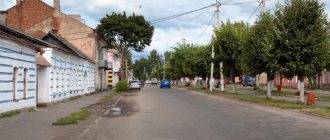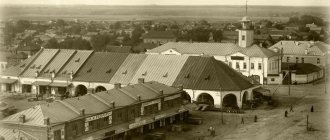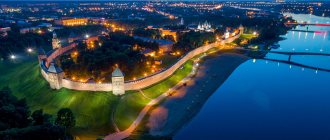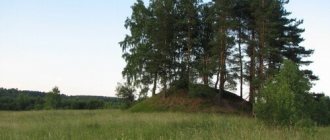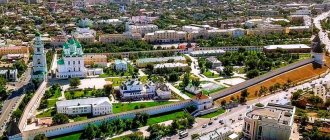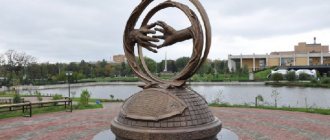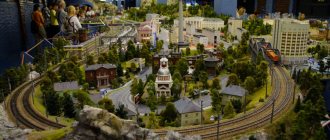Number 53 on car license plates indicates vehicle registration in the Novgorod region . The subject was formed in the summer of 1944 by decree of the Presidium of the USSR Armed Forces on the basis of areas withdrawn from the Leningrad and Kalinin regions. Subsequently, the list of reporting territories was adjusted several times, in the mid-90s. last century, the subject received code 53 (in accordance with the position of the region according to the list approved in the Constitution of the RSFSR of 1978).
Main city
The center of the subject of the Russian Federation 53 is Veliky Novgorod , founded in 859 and having the name Novgorod until 1999. The population, according to data for 2022, is almost 225 thousand people. (almost 33% of the region’s residents). The city is divided into 2 asymmetrical parts by the Volkhov River. At a distance of 6 km from Veliky Novgorod there is a large freshwater lake Ilmen.
Federal District
The region's territory is part of the Northwestern Federal District , which also includes:
- Arkhangelsk, Vologda, Kaliningrad, Leningrad, Murmansk and Pskov regions;
- Republics of Karelia and Komi;
- Nenets Autonomous Okrug
- city of St. Petersburg (capital of the district).
Yandex.Maps Northwestern Federal District — Yandex.Maps
Political structure
The Novgorod feudal republic was formally governed by a prince, but in reality the system of government can be represented in the form of an inverted triangle.
The real power was with the Veche and the boyars. Suffice it to say that it was the veche that appointed the prince, and it could also expel him. In addition, at the citywide assembly, which functioned within the framework of the boyar council (300 gold belts), the following were appointed:
- The prince was invited along with his squad. His residence was outside the city. The main task is to protect Novgorod land from external threats.
- Posadnik is the head of the city administration. His tasks are monitoring the prince, court in the cities, and governing the cities. He was subordinate to the city's street elders.
- Tysyatsky - head of the city administration and city militia (assistant mayor). He was involved in population management.
- The archbishop is the head of the Novgorod church. Tasks: storage of archives and treasury, responsibility for external relations, monitoring of trade, compilation and preservation of chronicles. The archbishop was confirmed by the Moscow metropolitan.
The prince could be summoned by the Novgorodians, but he could also be expelled, which happened often. A gift (agreement) was concluded with the prince, which indicated the rights and obligations of the prince. The prince was seen only as a protector against foreign invaders, but had no influence on domestic politics or the appointment/removal of officials. Suffice it to say that during the 12th-13th centuries the princes in Novgorod changed 58 times! Therefore, we can safely say that the real power in this principality belonged to the boyars and merchants.
The political independence of the Novgorod Republic was formalized in 1132-1136 after the expulsion of Prince Vsevolod Mstislavich. After this, the Novgorod land eliminated the power of Kyiv and became a virtually independent state with a republican form of government. Therefore, it is customary to say that the Novgorod state was a boyar republic with elements of a system of city self-government.
Coat of arms of the region
The region of the Russian Federation with code 53 has a coat of arms consisting of a central silver field with 2 symmetrical black bears holding a golden throne on a pedestal (the seat has a red cushion). Along the perimeter are oak leaves and St. Andrew's blue ribbon; on top of the shield is the imperial crown. The coat of arms was approved in the fall of 1995 and has not changed over the subsequent years.
Big cities
The list of major settlements includes:
- Velikiy Novgorod ;
- Staraya Russa (about 28 thousand inhabitants);
- Borovichi (about 49 thousand people).
Other cities in the region have from 8.5 to 15 thousand inhabitants. For example, in Valdai, according to data at the beginning of 2020, just under 14 thousand people are registered, the same number of people live in the city of Chudovo. The smallest is Holm, founded in 1144. As of 2022, the number of inhabitants is about 3.4 thousand people. According to statistics, the population of cities in the region is declining (except for Veliky Novgorod). As a result of extinction, the settlements of Demyansk and Kresttsy lost the title of cities and moved into the category of urban-type settlements.
Cities of the Novgorod region
Velikiy Novgorod
- the capital of the region. Population - 218 thousand people. The city is very clean, beautiful and green. There are many historical monuments, which is why tourists love to visit it, both during one-day excursions from St. Petersburg and directly. Other advantages: low crime rate, developed infrastructure. In 2010, Novgorod received the title of “The Most Comfortable City in Russia.” Cons: low salaries, very difficult to get a job. Another problem is the environment. Although chemical production no longer pollutes the air as much as in perestroika times, the water in rivers contains quite a lot of harmful substances. Car exhaust fumes also seriously deteriorate the quality of urban air.
City administration building in Novgorod
Borovichi
(53 thousand people) - the second largest city in the Novgorod region. It was here that the first arched bridge in Russia was built. Industry is poorly developed, mainly food production. Pros: good environmental situation. Cons: Difficulty finding a job.
Staraya Russa
(31 thousand people) - the city is really “old”. Historians believe that it was founded back in the 11th century - birch bark letters refer to this, and archaeological excavations are providing more and more evidence of this theory. Now, unfortunately, the city is close to extinction. Recently, the number of its inhabitants has been decreasing by a thousand people every year. This is not surprising: local residents prefer to seek their fortune in larger cities, where there are jobs and prospects.
Nationalities
On the territory of Veliky Novgorod (region number - 53) and the region there live (according to the 2010 census) several main nationalities. The percentage composition is given in the table.
| Nationality | Share of population, % |
| Russians | 88,36 |
| Ukrainians | 1,11 |
| Gypsies | 0,57 |
| Belarusians | 0,54 |
| Other nationalities | 2,37 |
| Those who have not decided on nationality or have not provided information | 7,05 |
Economic features
The lack of good arable land led to the active development of crafts and trade in the Novgorod Republic . Among the crafts that stood out were: iron production, fishing, hunting, salt making and other crafts characteristic of the northern regions. Trade was mainly carried out with neighboring regions: the Baltic states, German cities, Volga Bulgaria, Scandinavia.
Novgorod was the richest trading city in Rus'. This was achieved by the advantageous geographical location, as well as the presence of trade relations with various regions, including with Byzantium and the Caucasus. Basically, Novgorodians traded furs, honey, wax, iron products, pottery, weapons, and so on.
Administrative division
The 53rd region of Russia is divided into:
- 3 large cities of regional significance;
- 7 small towns that are regional centers ( region 53 is one of the outsiders in the Russian Federation );
- 11 urban-type settlements;
- 113 settlements;
- number of small villages not stated in official reports.
Transport infrastructure (roads)
Current state.
Cars are the main mode of transport in the region. The number of road sections in the region is several times higher than the national average. The region is famous for the Center – Scandinavia highway. There are also roads: Novgorod - Daugavpils, Shimsk - St. Russa - Velikiye Luki - Nevel and others.
The M10 (E 105) Moscow – St. Petersburg (or “Russia”) highway plays an important role, being one of the main routes for tourist lines – it covers a large number of settlements. Moreover, at any time of the year there are no critical deviations from the temperature on the route.
Some roads in the region are interconnected. Thus, the highway P21 (A116) Veliky Novgorod - Pskov connects the transport routes M10 "Russia" and M20 "Pskov".
The asphalt surface of most road sections is made using modern technologies.
Despite the fact that the region is rich in communication routes, there are problems with the condition of the roads. In certain parts of the roads, the technical specifications do not meet the standards and traffic density, which leads to traffic jams or vehicle malfunctions. In spring and autumn, some roads become impassable. In some areas of the city, the coating has become unusable and requires immediate repair.
Planned changes in transport infrastructure.
Currently, the Government of the Novgorod Region has developed a project in accordance with which roads should be improved. This is due to low traffic capacity (especially the M10 highway), the deterioration of some sections of roads, and the influence of seasons on the condition of roads and traffic on them.
It should be noted that active construction of the M11 Moscow-St. Petersburg toll highway is underway, which should increase the capacity of the M10 highway. The work is expected to be completed by 2022.
Transport
Transport in the region is represented by:
- railways;
- highways of various subordination;
- air communication lines (limited by the lack of an airfield);
- small river vessels.
Air
There is no official airport; there are sporadic charter flights using army airfields in Staraya Russa and Soltsy. Since 2022, the reconstruction of the Krechevitsy military airfield within the boundaries of Veliky Novgorod has been underway, which is expected to be used for the needs of civil aviation.
Automotive
The following trails pass through the territory:
- federal M10 (“ Russia ”, connecting Moscow and St. Petersburg);
- federal P56;
- M11 expressway.
The total length of highways is almost 15 thousand km, some of the objects are of federal importance (about 3%), the rest are assigned to municipalities or belong to local routes of communication.
Railway
The regional center is connected by railways with the capitals of neighboring regions and other large cities (for example, Moscow, St. Petersburg, Minsk or Brest). Construction of additional highways for the delivery of goods and transportation of tourists is underway.
Water
River transport in the region is poorly developed and is represented by private boats and small vessels. There are tourist routes that transport people on motorized boats.
Geographical position
The Novgorod principality or Novgorod land (republic) was located in the northern part of Rus' from the Arctic Ocean to the upper reaches of the Volga, and from the Baltic Sea to the Ural Mountains. The capital is Novgorod. Large cities: Novgorod, Pskov, Staraya Russa, Ladoga, Torzhok, Korela, Pskov and others.
Map of Novgorod land in the 12th-13th centuries.
The specificity of the geographical location was the almost complete absence of agriculture, since the soil was unsuitable for agriculture, as well as the remoteness from the steppes, due to which Novgorod practically did not see the Mongol invasion. At the same time, the principality was constantly subjected to military invasions by the Swedes, Lithuanians and German knights. Thus, it was the Novgorod lands that were the shield of Rus', which protected it from the North and West.
Geographical neighbors of the Novgorod Republic:
- Vladimir-Suzdal Principality
- Principality of Smolensk
- Principality of Polotsk
- Livonia
- Sweden
Attractions
On the territory of the subject there are a large number of monasteries and cathedrals, some of which were built before the 18th century. For example, within the boundaries of Veliky Novgorod, the Alekseevskaya or White Tower, built no later than the 16th century, has been preserved. to protect the populated area. Attractions include the Museum of the North-Western Front, located in Staraya Russa, the house-museum of F.M. Dostoevsky. Since the beginning of the 2010s. Ethnographic parks are being built (for example, the Slavic Village, depicting a settlement of the early 10th century).
Culture
Novgorod is one of the largest cities of its time. It is no coincidence that he is often called Mister Veliky Novgorod. In the center of the city was the St. Sophia Cathedral. The pavements in the city were paved with logs and were constantly renewed. The city itself was surrounded by a moat and wooden walls. The city practiced wood and stone construction. As a rule, churches and temples were built of stone, one of the functions of which was to store money.
Chronicles, fairy tales and epics were created in the Novgorod land. Much attention was paid to icon painting. The brightest painting of that era is “Angel with Golden Hair,” which today can be seen in the Russian Museum of St. Petersburg.
Architecture and fresco painting also developed in the principality. The main direction of development is realism.
